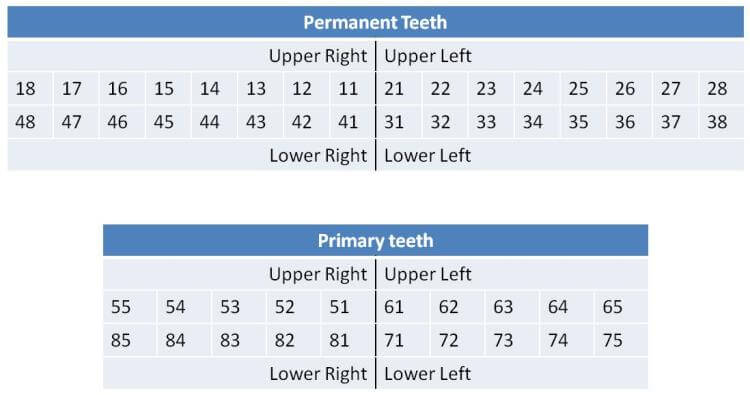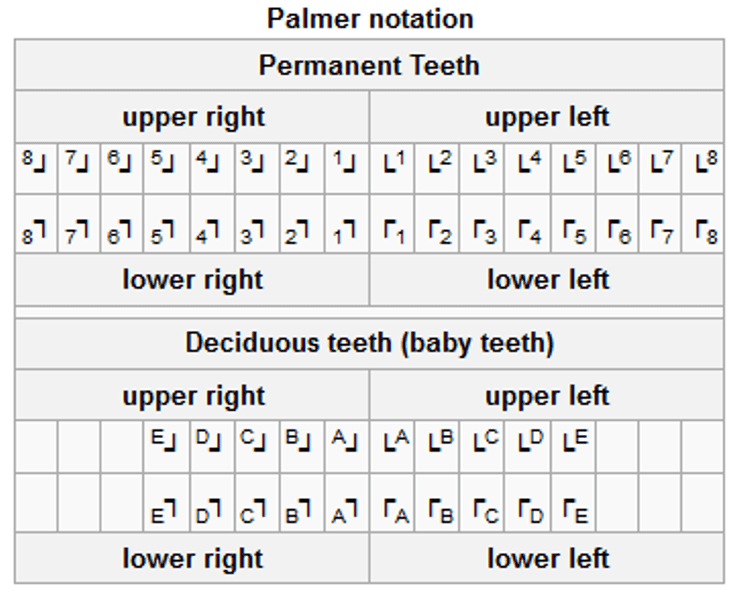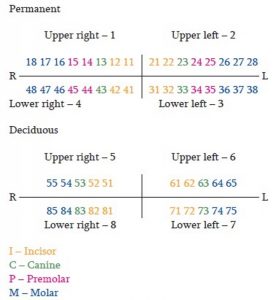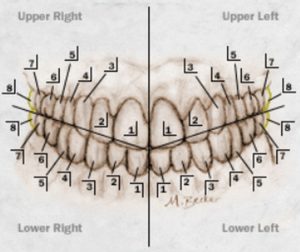There are times when a person needs to know about the tooth numbering. Particularly, when one is about to refer to a specific tooth, it is a lot easy to use a tooth number for this purpose. It can make it easy for you to make a reference. At times, you have to make speeches in concern with the dental issues and provide some suggestions. In these speeches, using the dental notation can make a great difference. There are three types of tooth numbering system. One is the Palmer notation method while the other one is a universal system of tooth numbering.
At first, people were using Palmer notation but later they find the use of the universal method and ISO notation system easy and switched to it.There are three types of tooth numbering system. One is the Palmer notation method while the other one is a universal system of tooth numbering. At first, people were using Palmer notation but later they find the use of the universal method and ISO notation system easy and switched to it. Below you can find information about these types of tooth notation system.
Table of Content
- Why do we need it?
- Types of Tooth Numbering systems
- International or FDI Tooth Numbering System
- For Permanent Teeth
- For Primary Teeth
- Palmer Dental Numbering System
- Permanent Teeth
- Primary Teeth
- Universal or ADA Dental Numbering System
- Permanent Teeth
- Primary Teeth
- ISO Dental Tooth Numbering System
- Permanent Teeth
- Primary Teeth
- Number and Letter Dental System
Why do we need it?
Dentists used this system to give a number to a particular tooth. “Shorthand” dental system is necessary to record data in clinical work. It is important of a dentist to choose a specific system of tooth numbering to do so efficiently.
Types of Tooth Numbering systems
There are several types in the world, But we will explain some types which are mostly used by dentists and orthodontists.
- International or FDI Dental Numbering system
- Zsigmondy/Palmer Dental Numbering System
- Universal or ADA Dental Numbering System
- ISO Dental Numbering System
International or FDI Tooth Numbering System
Teeth can be numbered according to the FDI, FDI stands for Federation Dentaire Internationale system for the teeth. It is considered as the international system for the numbering of the teeth. The numbering of teeth according to the tooth numbering system is as follow:
For Permanent Teeth
For adults, the mouth is divided into the 4 quadrants in a clockwise direction. These quadrants are numbered from 1 to 4. The numbering of the quadrants starts from the upper left side of the mouth. The number of the teeth in the adults starts from the 1 to 8. The numbering starts from the central incisor to the third molar of wisdom teeth.
Quadrant numbers are:
- 1 for Maxillary Right
- 2 for Maxillary Left
- 3 for Mandibular Left
- 4 for Mandibular Right
For Primary Teeth
For children, the mouth is divided into the 4 quadrants in a clockwise direction. These quadrants are numbered from 5 to 8. The numbering of the quadrants starts from the upper right side of the mouth. The number of the teeth in the adults starts from the 1 to 5. The numbering starts from the central incisor to the premolar.
Quadrant numbers are:
- 5 for Maxillary Right
- 6 for Maxillary Left
- 7 for Mandibular Left
- 8 for Mandibular Right
Palmer Dental Numbering System
The palmer dental numbering system is used by the orthodontist, oral surgeons, and pedodontists. It is considered as the international system for the numbering of the teeth. The numbering of teeth according to the teeth numbering system is as follow:
Permanent Teeth
In palmer system of tooth numbering, the mouth is divided into four quadrants. Each quadrant is numbered from 1 to 8. The numbers start from 1 for central incisor to 8 for the third molar. To identify the left and right teeth the brackets are introduced in it. The brackets are put like this (┘└ ┐┌)
Primary Teeth
In palmer tooth numbering system the mouth is divided into four quadrants. Each quadrant is numbered from the capital letters starting from A to E. The numbers start from A for central incisor to E for the premolar. To identify the left and right teeth the brackets are introduced in it. The brackets are put like this (┘└ ┐┌)
Universal or ADA Dental Numbering System
The universal teeth numbering system is used by the orthodontist, oral surgeons, and pedodontists and the American Dental. It is commonly used in the United States. It is considered as the international system for the numbering of the teeth. The numbering of teeth is as follow:
Permanent Teeth
In the universal or ADA teeth numbering system, the counting of the teeth starts from the 1 to 32. The diagram that we make in the flow chart will show that the numbering starts from the upper right to the upper left and lower left to lower right. The counting is given in the table.
| Upper right | Upper Left | ||||||||||||||
| 1 | 2 | 3 | 4 | 5 | 6 | 7 | 8 | 9 | 10 | 11 | 12 | 13 | 14 | 15 | 16 |
| 32 | 31 | 30 | 29 | 28 | 27 | 26 | 25 | 24 | 23 | 22 | 21 | 20 | 19 | 18 | 17 |
| Lower right | Lower Left | ||||||||||||||
Primary Teeth
Primary teeth are a number of the letters starting from A to T. The diagram that we make in the flow chart will show that the numbering starts from the upper right to the upper left and lower left to lower right. The counting is given in the table.
| Upper right | Upper Left | ||||||||
| A | B | C | D | E | F | G | H | I | J |
| T | S | R | Q | P | O | N | M | L | K |
| Lower right | Lower Left | ||||||||
The above numbering will help the dentist when he is going to operate the tooth of the patient.
ISO Dental Tooth Numbering System
The International Standards Organization (ISO) announced this notation system, and it is also known as the ISO 3950.This system was based upon the FDI and follows the same notations as FDI. It is considered as the international system for the numbering of the teeth. The numbering of teeth is as follow:
Permanent Teeth
For adults, the mouth is divided into the 4 quadrants in a clockwise direction. These quadrants are numbered from 1 to 4. The numbering of the quadrants starts from the upper left side of the mouth. The number of the teeth in the ad
ults starts from the 1 to 8. The numbering starts from the central incisor to the third molar of wisdom teeth.
Quadrant numbers are:
- 1 for Maxillary Right
- 2 for Maxillary Left
- 3 for Mandibular Left
- 4 for Mandibular Right
Primary Teeth
For children, the mouth is divided into the 4 quadrants in a clockwise direction. These quadrants are numbered from 5 to 8. The numbering of the quadrants starts from the upper right side of the mouth. The number of the teeth in the adults starts from the 1 to 5. The numbering starts from the central incisor to the premolar.
Quadrant numbers are:
- 5 for Maxillary Right
- 6 for Maxillary Left
- 7 for Mandibular Left
- 8 for Mandibular Right
Number and Letter Dental System
This number system is also based upon the palmar system, it is considered as the international system for the numbering of the teeth. The numbering of teeth is as follow in this system:
Permanent Teeth
In Number and tooth dental system the mouth is divided into four quadrants. Each quadrant is numbered from 1 to 8. The numbers start from 1 for central incisor to 8 for the third molar. To identify the left and right teeth the brackets are introduced in it. The brackets are put like this (┘└ ┐┌)
Quadrant numbers are:
- UR for Maxillary Right
- UL for Maxillary Left
- LL for Mandibular Left
- LR for Mandibular Right
Primary Teeth
In Number and tooth dental system the mouth is divided into four quadrants. Each quadrant is numbered from the capital letters starting from A to E. The numbers start from A for central incisor to E for the premolar. To identify the left and right teeth the brackets are introduced in it. The brackets are put like this (┘└ ┐┌).
Quadrant numbers are:
- UR for Maxillary Right
- UL for Maxillary Left
- LL for Mandibular Left
- LR for Mandibular Right
The above is information about the tooth numbering system, and you get to know about the three types of dental notation system. Hope that you find this guide helpful, and now you can point towards any of your teeth easily and write about the teeth in your speeches effectively. If there is still any confusion, you can always ask for comments.





Good